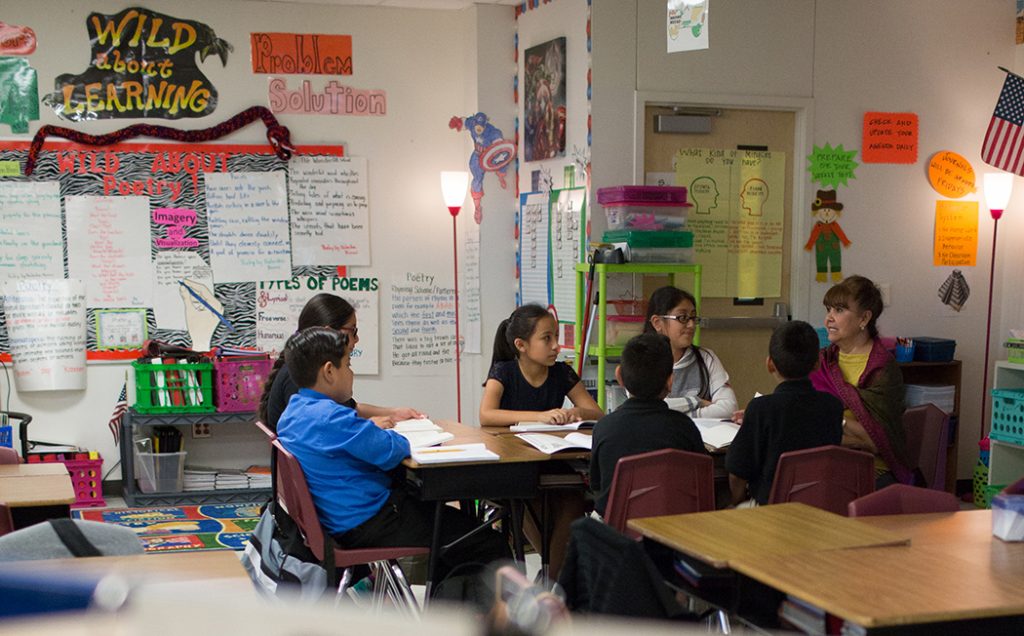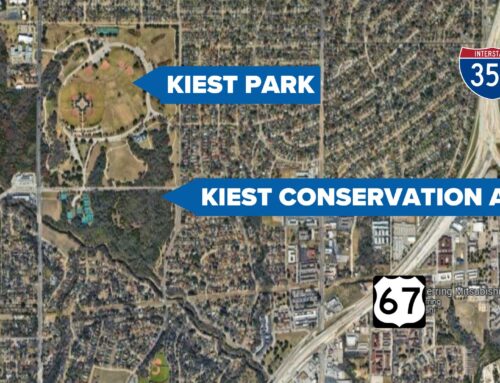Advocate Media’s podcast, The Uninformed Parent, now makes the transcripts of its audio available so that subscribers can either listen or read (or both), depending on their preference.
Below is the transcription of Episode 13: What you can’t learn about a school from an online search. Listen to this episode on our website or using the podcast app of your choice, and please subscribe to The Uninformed Parent to support this podcast production and be the first to be notified of new episodes.
It’s one thing to research a school online. It’s another altogether to take a tour and experience it for yourself.
In this episode, we accompany Becca Leonard on a tour of Felix G. Botello Elementary. It’s the school her neighborhood is zoned to and where her young children may attend someday, though few of her neighbors currently opt to send their children there.
The tour demonstrates Botello’s commitment to each child, through both its “personalized learning” curriculum and its AVID program, which creates an atmosphere of high expectations. Both encourage critical thinking and foster a culture of learning that begins early on. Even kindergartners at Botello are challenged to journal.
Even though Botello is impressive on paper, touring the school left an even stronger impression.
Assistant Principal Doris Lewis: Welcome, y’all, to Felix G. Botello Elementary School. We are pre-K 3 through fifth-grade. Our building is about 12 years old, and it’s simply beautiful. We have high ceilings. Our students are well behaved. That really benefits us greatly, because we’ve had five distinctions out of six for the state for at least two to three years. Prior to that, the distinctions were increasing. So, we went from three distinctions to five last year and five the previous year. Other elementary schools in our feeder have actually lost their distinctions.
Keri Mitchell: How many elementaries are in your feeder?
Doris Lewis: There’s five.
Keri Mitchell: This is so pretty.
Doris Lewis: Yes. So as you look, it’s somewhat of an open concept, and when you walk into our double doors from this side, we have our cafeteria area. It is assigned seating. We allow the teachers to decide if do they want to do boy, girl, boy, girl or do they want to put them in abc order, but the seats are assigned.
Keri Mitchell: I love the banners of the colleges above the cafeteria. So neat.
Doris Lewis: Yes, and so the good thing about our school is we are an AVID school, so we focus on high marks and achievement. Hey, everybody! Everybody goes on a field trip to a college. We have one mandatory field trip that is a college tour.
Keri Mitchell: The kindergarteners?
Doris Lewis: The kindergarteners. So our pre-K, last year they went to UT Arlington, so they get to choose whichever college or university they want to take a trip. So, fourth-grade last year went to Baylor. It’s not a dime for any of our kids, and that’s every grade level, every year. We are now going down to pre-K where they’re going to use a journal, and with their journals they will be able to showcase an example through math and then they can also have an image that they create to show their work. It’s just an organizational tool to keep our kids on track, showing them how to use calendars and a planner and to effectively plan their strategies.
Keri Mitchell: So when does personalized learning start?
Doris Lewis: So, this is our first year of personalized learning. So the school was approved last school year; we hired a Washington, D.C., firm called Educational Elements, and they have five scheduled face-to-face visits where they provide professional development to our teachers and our staff. Then the principal, Ms. Puente, and myself, [assiatant principal] Doris Lewis — we are part of what’s called the PL council. We are basically taking the feedback that our teachers give to create a plan and a vision for our next steps. So our implementation goal is Dec. 1, [2017], where the whole school will be in a personalized learning mode. What that means is our teachers will have rotation set up, and we’re focusing on a blended rotation model. And a blended rotation model, it’s no longer just, “Oh, you go to stations or you go to centers.” These centers are focused primarily on student needs, so if someone is deficient in, let’s say, nouns, but someone else is really good at adjectives, they’re not going to have the same profile or the same activity to do on the computer or in the small group. Our teachers have data walls and — I’m going to show you. We had an area last year, we called it the war room, but now it’s just called the data room because last year’s theme was military, so that’s why it was called a war room. I’m going to show you that room.
Keri Mitchell: This is a really neat room. Is this science or art?
Doris Lewis: This is our art room, and this is our wonderful art teacher, Ms. Brooks, who is also certified in leadership to be a principal, so we have a lot of talent here. Our teachers are highly educated. They’re highly qualified, and they provide a lot of structure to our advancement. Everything that this group of teachers is learning is geared towards personalized learning.
Keri Mitchell: If you are a parent of a student who’s going through personalized learning, what does that mean for your kid? What’s happening with your kid in a classroom that’s different, maybe, than a traditional one?
Doris Lewis: That’s a very good question. So, the difference between a traditional classroom versus personalized learning is a traditional classroom focuses on whole group instruction for everyone. It doesn’t matter whether you’re high in one thing or you’re low in another, you’re all getting the same information. And what we’ve noticed with traditional classrooms is, those students get left behind that are really low or that are really high. The ones in the middle get everything, but we’re not getting all kids. So the personalized learning concept allows us to touch everyone.
Keri Mitchell: So there is still group learning and group education. They’re just split off once …?
Doris Lewis: Absolutely. So there’s one classroom that I want to show you. We’re going to have a professional development later on this week, and this particular teacher is really good with showing her stations … how to do flexible seating. So that’s something that’s personalized learning. It’s not, “Sit at the desk” or “Sit on the carpet.” They’re like, “You know, I don’t want to sit in the desk, I want to stand or I want to be in another section of the classroom.” So we’re going to go into a fourth-grade classroom, and we’ll just see how her tables are labeled and how she runs her stations.
So, we’re just here visiting because we were talking about your classroom being great with flexible seating. Can you kinda tell us a little bit?
Iliana Ortega: I know they like to sit in, you know, the beanbags, the tall chairs. So I know those can get a little disruptive sometimes, so that’s where I put my independent work. And [in] independent work, they know exactly what to do. Then, I have my teacher station. I have little seats there, and I have a collaboration station which they know they can talk and collaborate about what we’re working on the class for that day.
Keri Mitchell: I see your exercise balls…
Iliana Ortega: On the computer, yes.
Keri Mitchell: So they sit on those for the computer?
Iliana Ortega: Yes, for the computers. They really liked those.
Keri Mitchell: How wonderful. How long have you been here?
Iliana Ortega: This is my third year.
Keri Mitchell: At this school?
Iliana Ortega: In teaching.
Keri Mitchell: Awesome.
Iliana Ortega: Yes.
Keri Mitchell: Thank you so much. Sorry to disrupt your classroom.
Iliana Ortega: Oh, no problem.
Doris Lewis: So now we’re going to enter the fifth-grade classroom, and Ms. Treviño is one of the two PL coordinators. When you talk about flexible seating and the room being organized with students, she is that person — that go-to person. So, she has really allowed teachers to gravitate towards her to learn how to do that. In traditional classrooms, you won’t see that, because the teachers are afraid to let go and let them try something different. It’s all about flexibility and options. So our kids know what they need to work on, but we give them the option of how they want to pursue it. So in the corporate world, the real world, we have a project to do. A lot of times our managers don’t say, “Do this first and do this first, and do this first.” They just say, “This is the project. Get it done.” And so we want our kids to be cognizant.
Hi, Ms. Treviño, if you could kind of really quickly walk us through your classroom, about your flexible seating, how you have things set up.
Eva Treviño: All right, so our rotation begins. I do Monday, Tuesday, Wednesdays, three-station rotation. So this is pretty much the independent station. We have the collaborative, and then we have the teacher station. Then, we have the technology stations. So teaching is going to vary based on where you’re at. And then I have the dessert menu and those are my dessert items over there. So, I have the fluency station, and then I have the read-to-self area in the perimeters of the room. Those are the read-to-self areas. And then I have that station over there. It’s called “Choices for the Dessert Menu,” and there’s just a bunch of games. The kids love moving around. I mean sitting in the same chair for an hour and a half and three rotations every day …
Keri Mitchell: There’s a lot of focus on reading, clearly, and I mean, that should be obvious, but it’s a very, very detailed kind of approach to how to make sure they’re reading fluently and comprehensively.

A group of fifth-graders listen to their teacher, Eva Treviño, during a book review discussion at Felix G. Botello Elementary. (Photo by Rasy Ran)
Eva Treviño: And how I used to do it in the past is, I used to go to them. My tables were the guided reading. And so maybe this table was independent and this table was guided. So, I would just roll my chair and go to the group, and I would just rotate around the room. But everybody always had to do independent because that’s how you reinforce what they’re doing. So, I would always start like that, but this year when we took on PL, we wanted our environment to also be a little different because they need to move around.
Keri Mitchell: How have you seen that change their education?
Eva Treviño: Well, my data is so much the same as last year. So if you’re talking about data, right now I’m about the same, but they like it better. You should ask them.
Keri Mitchell: How’s their behavior?
Eva Treviño: It’s good. Very good. I’m very strict, and so sometimes I’ll ring the bell and they just, you know.
Doris Lewis: We’re also doing DRAs. So in the past they had not done DRA; it’s called Diagnostic Reading Assessment, so that’s how you will find a child’s reading level. So it’s not like you’re higher, lower, medium. I’m just going to give you a book. No, this child is a level 10, and here’s a level 10 book that will go meet their needs. So now they have a tracking device for every student. So I know John Doe on September the 3rd was a level two. He should be a level 14 at the beginning of my classroom, so when I meet with him at my small group table, I can let John Doe know, “You should be a 14, but that’s OK. We’re going to work towards it. So let’s create a goal of what we can do within the next two weeks or the next month.” And so that’s what we’re focusing on this year with our primary grades.
Eva Treviño: Let me show you my independent station.
Keri Mitchell: Yeah.
Eva Treviño: Can you tell me a little bit about what to do? Before you stop and jot it, what do you have to do?
Fifth-grader: You have to do the title, the genre, and the prediction.
Eva Treviño: After you make your prediction, what are you going to do?
Fifth-grader: Make questions.
Eva Treviño: What kinds of questions? Thin questions or big, fat, juicy questions?
Fifth-grader: Big, fat, juicy questions.
Eva Treviño: Okay, good. So after you make your prediction, and you set the purpose for reading with three big fat, juicy questions, what are you going to do?
Fifth-grader: Read.
Eva Treviño: Read how many times?
Fifth-grader: Three times.
Eva Treviño: Why do we read the story three times?
Fifth-grader: To understand it better.
Eva Treviño: Then after we understand it better, what are we going to do?
Fifth-grader: Stop and jot.
Eva Treviño: And stop and jot is not what?
Fifth-grader: Copy it.
Eva Treviño: It’s not stop and copy. What is the next step after stopping and jotting?
Fifth-grader: React and reflect.
Eva Treviño: React and reflect — can you give me a stem from react and reflect?
Fifth-grader: “This reminded me …”
Eva Treviño: Very good! Awesome! After we reflect, what are we going to do?
Fifth-grader: Our summary.
Eva Treviño: And usually for informational texts it has to have a good beginning, middle and end. So, this is a week-long process.
Keri Mitchell: So they’d do this all week?
Eva Treviño: Yes, and so this is my independent station, and this is how I build stamina.
Keri Mitchell: Can you tell us a percentage of the kids, when they leave fifth-grade, what happens with those graduates?
Eva Treviño: Most of our students get into academies, which are the best schools in DISD. They are very chosen and good high quality schools, and I can tell you just because I’ve been here a while, a lot of our kids end up at the Townview High School, which is rated No. 1 in the nation. I have, like, 30 kids over there that I’ve had as fifth-graders. But the data last year, we had 52 percent at mastery level for reading.
Keri Mitchell: Excellent.
Becca Leonard: Maybe explain what that means. Someone may not be unfamiliar.
Eva Treviño: OK, so we have our state assessment, which is an assessment of all the Texas essential knowledge skills that we are responsible for teaching. Those are our curriculum. So then, they’re assessed at the end of the year, and you either pass it with a score or you barely pass it, which is minimum to me. Or you pass it at a mastery level, which is being college-ready. So 52 percent of my students last year that are in sixth-grade now passed it [with a] 52 percent mastery level.
Keri Mitchell: That’s remarkable. That’s really impressive.
Eva Treviño: So those kids, I see them because their siblings are here. When I see them, I always ask them, “How are you doing?” “Oh, Ms. Treviño. It’s very easy for me.” “Why is it easy for you?” “Because you made it so hard.” So they leave with a lot of knowledge, and I just saw a student Friday that I had. She’s a freshman in college, and so when she left here, went to middle school magnet, went to high school, early college. She’s at Stephen F. Austin [State University] and will graduate next year with a bachelor’s.
Keri Mitchell: Her sophomore year?
Eva Treviño: Her sophomore year.
Keri Mitchell: Two years. That’s incredible. That is incredible.
Eva Treviño: For me, their work is a reflection of my work, and so when they leave here, I feel like they are caught up. It can be life changing. If you can read and write, that’s survival.
Keri Mitchell: Thank you. It was so nice to meet you. I really appreciate it. Thank you.
Eva Treviño: Thank you so much for coming in!
Doris Lewis: You just want a peek into a math class, just a peek in. I’m going to take you to a third.
Becca Leonard: Keri, you want to see a younger grade at some point?
Keri Mitchell: I would love to just because mine’s little.
Doris Lewis: OK, yeah. We’ll go downstairs real quick, and we’ll look at a first-grade.
Keri Mitchell: You guys do have afterschool or only in extracurriculars?
Doris Lewis: So we have robotics. We have — oh my gosh. I literally have to look at my computer. I think we have 15- 20 afterschool activities, so every teacher is responsible for doing an extracurricular activity. This is a pre-K 4. We have one of the pre-K teachers focus on social studies and science. One of them focuses on reading, the other focuses on math, and they do a rotation within themselves. The kids travel to the three different classes.
Keri Mitchell: So there are three classes of pre-K?
Doris Lewis: Yes. There are three classes of pre-K.
Keri Mitchell: How many are there for other grades?
Doris Lewis: So on average for our primaries, [there’s] like three. First-grade, I believe that there’s four. Second, there may be four, and then the higher we go up, there’s four to five.
Keri Mitchell: Got It.
Doris Lewis: So our fourth and fifth, there’s four and five of each of those.
Keri Mitchell: Does that mean you’re getting more kids as they get older?
Doris Lewis: We are. Well, we’re getting more kids in general. The school is wonderful. Like, when I got here in March, I was like, it’s so pleasant. I’ll say maybe 25 percent of our staff has been here since the beginning. So for 12 years.
Keri Mitchell: How are your long-term teachers doing with PL integration?
Doris Lewis: Great. So, Ms. Treviño, she’s amazing. What we’re really pushing is our primary now because our third through fifth have always been on it. But this is a kinder class, And so they’re all at lunch and recess probably. So this is Mr. Ellet’s classroom. We can go ahead and peek in. So we have two PL coordinators, so I’ll take you to our other PL coordinator.
Doris Lewis: Her name is Ms. Karam, and so she’s the primary [coordinator]. We have visitors on campus who’re doing a tour, and so I’m telling them how you and Ms. Treviño are gurus for PL. You’re the primary. She’s intermediate. So if you want to kind of tell us about um, like the journaling, the things that you do with your class or anything you’d like to share. Just kind of tell us how you set things up. How do you group your kids? You know, when I’ve come in, I’ve seen, like, the journaling in first-grade that used to be like a third-grade and up, but they all have journals.
Keri Mitchell: I’m just kind of interested in how this works and how you’ve seen things or how you’ve changed things from kind of a traditional setting before to now?
Lorena Karam: What we are trying to do is trying to to address all our students needs, because they are so different. Even if they are in first-grade, we can see that some students need more than others. So for these, the school went through the personalized learning. So in order for that, before we analyze data, we did everything so we can prepare the material. So if one student comes, the work he or she has to do is totally different from what another needs to do. So the other station is right there. It’s the technology station. They going to the computer. They go to the programs that are personalized. So every student is having different, is having what they need. So when it’s time for the collaboration, they go to that area. And then lastly, we have a small table. So as I see, I check the work. Every work we do, I can make the groups and pull out the students. Even when one student is high, let’s say, or does not struggle. It can be that there’s a skill that he struggled with, so I just pull out the students that are struggling with the same skills.
Keri Mitchell: And they’re first-graders?
Lorena Karam: Yes, they’re first-graders.
Doris Lewis: And they’re journaling?
Lorena Karam: Yes. I am an advocate for writing, so for me, they don’t write, they don’t read. For me, they go both — the best way for them to read is through writing. When they finish early, they have articles.
Keri Mitchell: How does it work for students? If you have a student that is, maybe, excelling like crazy, how does this work for them? How does personalized learning work for them?
Lorena Karam: They have the option to go beyond. So last year, I had a class that was very above, so they just keep going and keep going and keep going. My goal is for them to be able to work independently. It’s not easy.
Keri Mitchell: Thank you. Thank you.
Doris Lewis: And then that door leads to our play area. Have you seen that yet?
Keri Mitchell: I saw it, because I drove past it.
Doris Lewis: So yeah, so we have two playground areas. So we pretty much have that separated by primary and intermediate. Then there’s a basketball court right in the middle here.
Keri Mitchell: How many kids do you have here?
Doris Lewis: We have about 560.
Keri Mitchell: How many can you fit?
Doris Lewis: I think we can fit up to 1,000. Yeah. So, they did like a capacity walk at the end of last year, and I want to say the max would be, like, around a thousand students. So we still have space.
Keri Mitchell: Student-to-teacher ratios?
Doris Lewis: Our older grades it might be about 19-to-1, and our primary grades, I believe it’s closer to 18-to-1.
Keri Mitchell: And so transfer-in has not been a problem?
Doris Lewis: No, not at all. And this is our auditorium.
Keri Mitchell: Oh yeah, it’s beautiful.
Doris Lewis: Go ahead and go on in.
Keri Mitchell: It’s really nice. So do the kids come in here for anything in particular or just …?
Doris Lewis: We had a little skit that we did for Halloween — “Miss Nelson Has a Field Day” — so we did that one. Our PE coach is a DJ, so he brought his music. When it was over, we brought them up, you know, we asked them a couple of questions like, “Who were the characters?” Depending on their grade. Then we had a couple of them come up and actually dance, and they wiggled themselves away. So any program that we have, it’s in here. We have PTA nights, and the same day as PTA night is when we’ll have fourth-grade performance or kinder performance.
Keri Mitchell: Thank you so much.
Doris Lewis: Oh, you’re welcome.
Keri Mitchell: This was great.
Thanks for listening to The Uninformed Parent. In the next episode, we’ll talk to Botello Elementary principal Maria Puente.
This podcast is a production of Advocate magazines with music by HookSounds.





